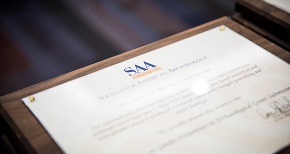Please be aware when registering, all times are in the Eastern Time Zone. Even for free events, you will need to click the "Proceed to Checkout" button and "Submit Order"
to complete your registration. If you do not receive an automated confirmation email, or if you have any questions about registration, please email
onlineseminars@saa.org.
![[Foundational Skills] Story Maps for Public Archaeology](/images/default-source/opengraph/onlineseminars/computer.tmb-seminar.jpg?Culture=en&sfvrsn=d29976d9_1)
Registration Closed!
[Foundational Skills] Story Maps for Public Archaeology
When: September 06, 2022 1:00-2:00 PM ET
Duration: 1 hour
Certification: RPA-certified
Pricing
Individual Registration: Free to SAA members; $69 for non-members
Group Registration: Free to SAA members; $89 for non-members
Tonya Fallis, MA, RPA, GISP, City of McKinney, TX
Tonya Fallis received her MA in Archaeology from Eastern New Mexico University in 2002. She specializes in geospatial and database applications in archaeology and created her first GIS-based predictive model back in the 90s, when 30-meter Landsat data was still considered pretty cool. She was an archaeologist and GIS Specialist at New Mexico's Archaeological Records Management Section for twelve years. In the private sector, she worked with GIS in natural and cultural resource conservation, including the design of an archaeological site management system for the City of Santa Fe. She currently works as a Senior GIS Analyst for the City of McKinney, Texas, where she uses GIS to support public history and heritage education.
Tonya Fallis received her MA in Archaeology from Eastern New Mexico University in 2002. She specializes in geospatial and database applications in archaeology and created her first GIS-based predictive model back in the 90s, when 30-meter Landsat data was still considered pretty cool. She was an archaeologist and GIS Specialist at New Mexico's Archaeological Records Management Section for twelve years. In the private sector, she worked with GIS in natural and cultural resource conservation, including the design of an archaeological site management system for the City of Santa Fe. She currently works as a Senior GIS Analyst for the City of McKinney, Texas, where she uses GIS to support public history and heritage education.
Story Maps are an excellent resource for engaging the public with archaeology and heritage education. They can be used to communicate the results of archaeological research, and provide a medium for telling the stories of underserved populations. Story Maps can also be used at low cost for non-profit or educational purposes, allowing organizations with scarce resources to create their own stories on an easily-accessible platform.
1. Describe Story Map designs and how they use geospatial data, text, and multimedia to achieve different goals.
2. Review the options available for Story Maps based on free, low-cost, and full-priced Esri accounts.
3. Outline best practices behind production, design and maintenance of a Story Map, including issues of special interest to archaeologists.
2. Review the options available for Story Maps based on free, low-cost, and full-priced Esri accounts.
3. Outline best practices behind production, design and maintenance of a Story Map, including issues of special interest to archaeologists.


